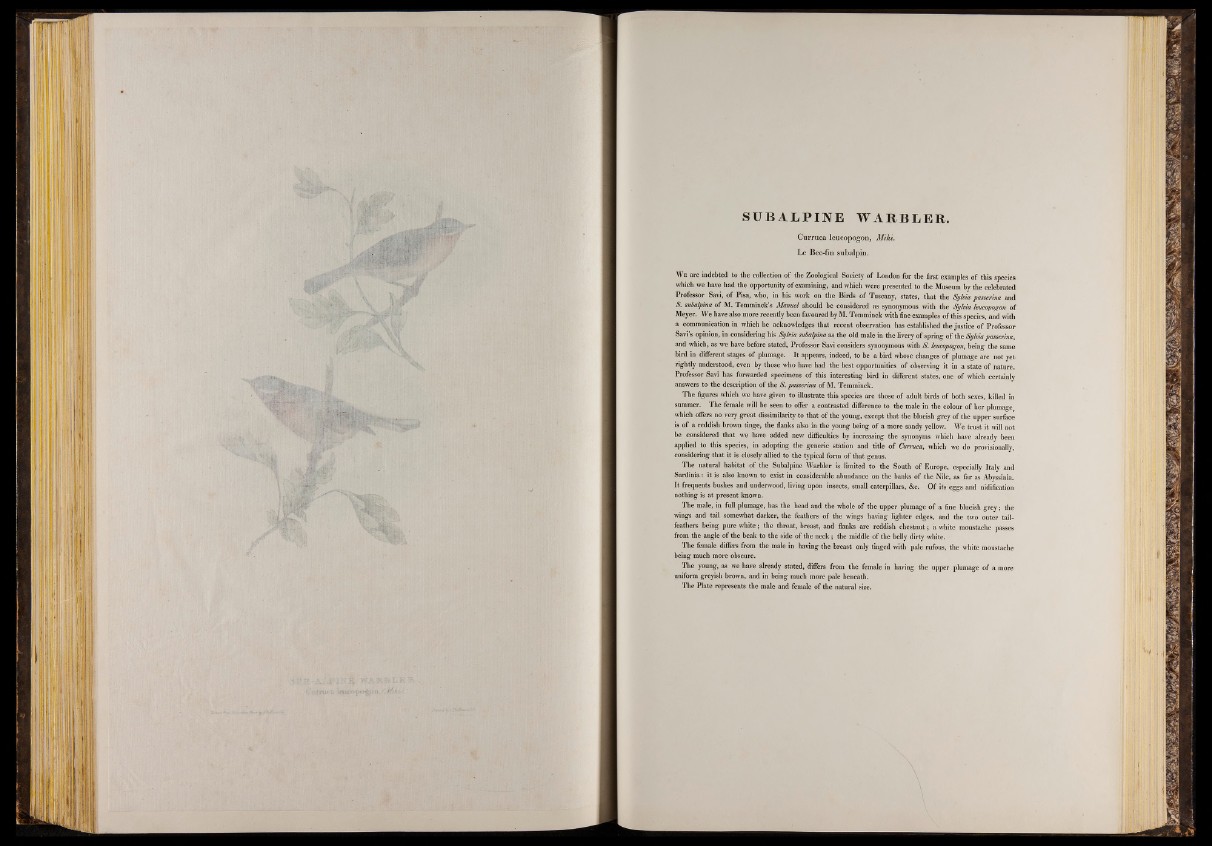
S U B A L P I N E WA R B L E R .
Curruca leucopogon, Mihi.
Le Bec-fin sukalpin.
We are indebted to the collection of the Zoological Society of London for the first examples of this species
which we have had the opportunity of examining, and which were presented to the Museum by the celebrated
Professor Savi, of Pisa, who, in his work on the Birds of Tuscany, states, that the Sylvia passerina and
S. subalpina of M. Temminck’s Manuel should be considered as synonymous with the Sylvia leucopogon of
Meyer. We have also more recently been favoured by M. Temminck with fine examples of this species, and with
a communication in which lie acknowledges that recent observation has established the justice of Professor
Savi’s opinion, in considering his Sylvia subalpina as the old male in the livery of spring of the Sylvia passerina,
and which, as we have before stated, Professor Savi considers synonymous with S. leucopogon, being the same
bird in different stages of plumage. It appears, indeed, to be a bird whose changes of plumage are not yet
rightly understood, even by those who have had the best opportunities of observing it in a state of nature.
Professor Savi has forwarded specimens of this interesting bird in different states, one of which certainly
answers to the description of the S. passerina of M. Temminck.
The figures which we have given to illustrate this species are those of adult birds of both sexes, killed in
summer. The female will be seen to offer a contrasted difference to the male in the colour of her plumage
which offers no very great dissimilarity to that of the young, except that the blueish grey of the upper surface
is of a reddish brown tinge, the flanks also in the young being of a more sandy yellow. We trust it will not
be considered that we have added new difficulties by increasing the synonyms which have already been
applied to this species, in adopting the generic station and title of Curruca, which we do provisionally,
considering that it is closely allied to the typical form of that genus.
The natural habitat of the Subalpine Warbler is limited to the South of Europe, especially Italy and
Sardinia: it is also known to exist in considerable abundance on the banks of the Nile, as far as Abyssinia.
It frequents bushes and underwood, living upon insects, small caterpillars, &c. Of its eggs and nidification
nothing is at present known.
The male, in full plumage, has the head and the whole of the upper plumage of a fine blueish grey; the
wings and tail somewhat darker, the feathers of the wings having lighter edges, and the two outer tail-
feathers being pure white; the throat, breast, and flanks are reddish chestnut; a white moustache passes
from the angle of the beak to the side of the neck; the middle of the belly dirty white.
The female differs from the male in having the breast only tinged with pale rufous, the white moustache
being much more obscure.
The young, as we have already stated, differs from the female in having the upper plumage of a more
uniform greyish brown, and in being much more pale beneath.
The Plate represents the male and female of the natural size.